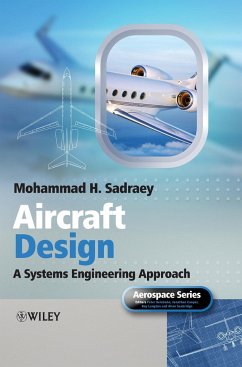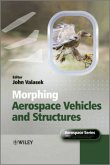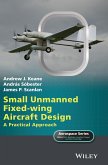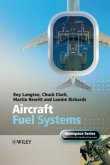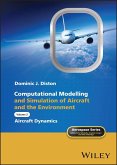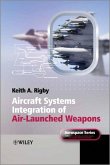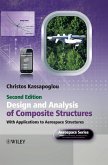- Gebundenes Buch
- Merkliste
- Auf die Merkliste
- Bewerten Bewerten
- Teilen
- Produkt teilen
- Produkterinnerung
- Produkterinnerung
A comprehensive approach to the air vehicle design process using the principles of systems engineering
Due to the high cost and the risks associated with development, complex aircraft systems have become a prime candidate for the adoption of systems engineering methodologies. This book presents the entire process of aircraft design based on a systems engineering approach from conceptual design phase, through to preliminary design phase and to detail design phase.
Presenting in one volume the methodologies behind aircraft design, this book covers the components and the issues affected by…mehr
Andere Kunden interessierten sich auch für
![Morphing Aerospace Vehicles and Structures Morphing Aerospace Vehicles and Structures]() John ValasekMorphing Aerospace Vehicles and Structures131,99 €
John ValasekMorphing Aerospace Vehicles and Structures131,99 €![Essentials of Supersonic Commercial Aircraft Conceptual Design Essentials of Supersonic Commercial Aircraft Conceptual Design]() Egbert TorenbeekEssentials of Supersonic Commercial Aircraft Conceptual Design121,99 €
Egbert TorenbeekEssentials of Supersonic Commercial Aircraft Conceptual Design121,99 €![Small Unmanned Fixed-Wing Aircraft Design Small Unmanned Fixed-Wing Aircraft Design]() Andrew J. KeaneSmall Unmanned Fixed-Wing Aircraft Design129,99 €
Andrew J. KeaneSmall Unmanned Fixed-Wing Aircraft Design129,99 €![Aircraft Fuel Systems Aircraft Fuel Systems]() Roy LangtonAircraft Fuel Systems149,99 €
Roy LangtonAircraft Fuel Systems149,99 €![Computational Modelling and Simulation of Aircraft and the Environment, Volume 2 Computational Modelling and Simulation of Aircraft and the Environment, Volume 2]() Dominic J. DistonComputational Modelling and Simulation of Aircraft and the Environment, Volume 2101,99 €
Dominic J. DistonComputational Modelling and Simulation of Aircraft and the Environment, Volume 2101,99 €![Aircraft Systems Integration of Air-Launched Weapons Aircraft Systems Integration of Air-Launched Weapons]() Keith Antony RigbyAircraft Systems Integration of Air-Launched Weapons117,99 €
Keith Antony RigbyAircraft Systems Integration of Air-Launched Weapons117,99 €![Design and Analysis of Composite Structures Design and Analysis of Composite Structures]() Christos KassapoglouDesign and Analysis of Composite Structures122,99 €
Christos KassapoglouDesign and Analysis of Composite Structures122,99 €-
-
-
A comprehensive approach to the air vehicle design process using the principles of systems engineering
Due to the high cost and the risks associated with development, complex aircraft systems have become a prime candidate for the adoption of systems engineering methodologies. This book presents the entire process of aircraft design based on a systems engineering approach from conceptual design phase, through to preliminary design phase and to detail design phase.
Presenting in one volume the methodologies behind aircraft design, this book covers the components and the issues affected by design procedures. The basic topics that are essential to the process, such as aerodynamics, flight stability and control, aero-structure, and aircraft performance are reviewed in various chapters where required. Based on these fundamentals and design requirements, the author explains the design process in a holistic manner to emphasise the integration of the individual components into the overall design. Throughout the book the various design options are considered and weighed against each other, to give readers a practical understanding of the process overall.
Readers with knowledge of the fundamental concepts of aerodynamics, propulsion, aero-structure, and flight dynamics will find this book ideal to progress towards the next stage in their understanding of the topic. Furthermore, the broad variety of design techniques covered ensures that readers have the freedom and flexibility to satisfy the design requirements when approaching real-world projects.
Key features:
Provides full coverage of the design aspects of an air vehicle including: aeronautical concepts, design techniques and design flowcharts
Features end of chapter problems to reinforce the learning process as well as fully solved design examples at component level
Includes fundamental explanations for aeronautical engineering students and practicing engineers
Features a solutions manual to sample questions on the book's companion website
Companion website - www.wiley.com/go/sadraey
Hinweis: Dieser Artikel kann nur an eine deutsche Lieferadresse ausgeliefert werden.
Due to the high cost and the risks associated with development, complex aircraft systems have become a prime candidate for the adoption of systems engineering methodologies. This book presents the entire process of aircraft design based on a systems engineering approach from conceptual design phase, through to preliminary design phase and to detail design phase.
Presenting in one volume the methodologies behind aircraft design, this book covers the components and the issues affected by design procedures. The basic topics that are essential to the process, such as aerodynamics, flight stability and control, aero-structure, and aircraft performance are reviewed in various chapters where required. Based on these fundamentals and design requirements, the author explains the design process in a holistic manner to emphasise the integration of the individual components into the overall design. Throughout the book the various design options are considered and weighed against each other, to give readers a practical understanding of the process overall.
Readers with knowledge of the fundamental concepts of aerodynamics, propulsion, aero-structure, and flight dynamics will find this book ideal to progress towards the next stage in their understanding of the topic. Furthermore, the broad variety of design techniques covered ensures that readers have the freedom and flexibility to satisfy the design requirements when approaching real-world projects.
Key features:
Provides full coverage of the design aspects of an air vehicle including: aeronautical concepts, design techniques and design flowcharts
Features end of chapter problems to reinforce the learning process as well as fully solved design examples at component level
Includes fundamental explanations for aeronautical engineering students and practicing engineers
Features a solutions manual to sample questions on the book's companion website
Companion website - www.wiley.com/go/sadraey
Hinweis: Dieser Artikel kann nur an eine deutsche Lieferadresse ausgeliefert werden.
Produktdetails
- Produktdetails
- Aerospace Series (PEP)
- Verlag: Wiley & Sons / Wiley-Blackwell
- 1. Auflage
- Seitenzahl: 808
- Erscheinungstermin: 26. Oktober 2012
- Englisch
- Abmessung: 250mm x 175mm x 48mm
- Gewicht: 1330g
- ISBN-13: 9781119953401
- ISBN-10: 1119953405
- Artikelnr.: 35215835
- Herstellerkennzeichnung
- Libri GmbH
- Europaallee 1
- 36244 Bad Hersfeld
- gpsr@libri.de
- Aerospace Series (PEP)
- Verlag: Wiley & Sons / Wiley-Blackwell
- 1. Auflage
- Seitenzahl: 808
- Erscheinungstermin: 26. Oktober 2012
- Englisch
- Abmessung: 250mm x 175mm x 48mm
- Gewicht: 1330g
- ISBN-13: 9781119953401
- ISBN-10: 1119953405
- Artikelnr.: 35215835
- Herstellerkennzeichnung
- Libri GmbH
- Europaallee 1
- 36244 Bad Hersfeld
- gpsr@libri.de
Mohammad H. Sadraey Daniel Webster College, New Hampshire, USA
Preface xv
Series Preface xix
Acknowledgments xxi
Symbols and Acronyms xxiii
1 Aircraft Design Fundamentals 1
1.1 Introduction to Design 1
1.2 Engineering Design 4
1.3 Design Project Planning 8
1.4 Decision Making 10
1.5 Feasibility Analysis 12
1.6 Tort of Negligence 15
References 17
2 Systems Engineering Approach 19
2.1 Introduction 19
2.2 Fundamentals of Systems Engineering 20
2.3 Conceptual System Design 23
2.3.1 Definition 23
2.3.2 Conceptual Design Flowchart 24
2.3.3 Technical Performance Measures 25
2.3.4 Functional Analysis 26
2.3.5 System Trade-Off Analysis 27
2.3.6 Conceptual Design Review 28
2.4 Preliminary System Design 29
2.5 Detail System Design 30
2.6 Design Requirements 33
2.7 Design Review, Evaluation, and Feedback 34
2.8 Systems Engineering Approach in Aircraft Design 37
2.8.1 Implementation of Systems Engineering 37
2.8.2 Design Phases 38
2.8.3 Design Flowchart 39
2.8.4 Design Groups 41
2.8.5 Design Steps 43
References 47
3 Aircraft Conceptual Design 49
3.1 Introduction 49
3.2 Primary Functions of Aircraft Components 50
3.3 Aircraft Configuration Alternatives 52
3.3.1 Wing Configuration 53
3.3.2 Tail Configuration 55
3.3.3 Propulsion System Configuration 55
3.3.4 Landing Gear Configuration 56
3.3.5 Fuselage Configuration 58
3.3.6 Manufacturing-Related Items Configuration 58
3.3.7 Subsystems Configuration 59
3.4 Aircraft Classification and Design Constraints 62
3.5 Configuration Selection Process and Trade-Off Analysis 68
3.6 Conceptual Design Optimization 74
3.6.1 Mathematical Tools 74
3.6.2 Methodology 76
Problems 86
References 92
4 Preliminary Design 93
4.1 Introduction 93
4.2 Maximum Take-Off Weight Estimation 94
4.2.1 The General Technique 94
4.2.2 Weight Build-up 95
4.2.3 Payload Weight 96
4.2.4 Crew Weight 97
4.2.5 Fuel Weight 100
4.2.6 Empty Weight 108
4.2.7 Practical Steps of the Technique 112
4.3 Wing Area and Engine Sizing 113
4.3.1 Summary of the Technique 113
4.3.2 Stall Speed 118
4.3.3 Maximum Speed 120
4.3.4 Take-Off Run 131
4.3.5 Rate of Climb 136
4.3.6 Ceiling 140
4.4 Design Examples 145
Problems 155
References 158
5 Wing Design 161
5.1 Introduction 161
5.2 Number of Wings 164
5.3 Wing Vertical Location 165
5.3.1 High Wing 165
5.3.2 Low Wing 168
5.3.3 Mid-Wing 169
5.3.4 Parasol Wing 169
5.3.5 The Selection Process 169
5.4 Airfoil Section 170
5.4.1 Airfoil Design or Airfoil Selection 171
5.4.2 General Features of an Airfoil 173
5.4.3 Characteristic Graphs of an Airfoil 176
5.4.4 Airfoil Selection Criteria 182
5.4.5 NACA Airfoils 183
5.4.6 Practical Steps for Wing Airfoil Section Selection 188
5.5 Wing Incidence 195
5.6 Aspect Ratio 198
5.7 Taper Ratio 203
5.8 The Significance of Lift and Load Distributions 206
5.9 Sweep Angle 209
5.10 Twist Angle 223
5.11 Dihedral Angle 226
5.12 High-Lift Device 230
5.12.1 The Functions of a High-Lift Device 230
5.12.2 High-Lift Device Classification 232
5.12.3 Design Technique 235
5.13 Aileron 241
5.14 Lifting-Line Theory 242
5.15 Accessories 246
5.15.1 Strake 247
5.15.2 Fence 247
5.15.3 Vortex Generator 248
5.15.4 Winglet 248
5.16 Wing Design Steps 249
5.17 Wing Design Example 250
Problems 259
References 264
6 Tail Design 265
6.1 Introduction 265
6.2 Aircraft Trim Requirements 268
6.2.1 Longitudinal Trim 270
6.2.2 Directional and Lateral Trim 276
6.3 A Review on Stability and Control 278
6.3.1 Stability 278
6.3.2 Control 282
6.3.3 Handling Qualities 284
6.4 Tail Configuration 285
6.4.1 Basic Tail Configuration 285
6.4.2 Aft Tail Configuration 288
6.5 Canard or Aft Tail 294
6.6 Optimum Tail Arm 298
6.7 Horizontal Tail Parameters 301
6.7.1 Horizontal Tail Design Fundamental Governing Equation 301
6.7.2 Fixed, All-Moving, or Adjustable 304
6.7.3 Airfoil Section 306
6.7.4 Tail Incidence 308
6.7.5 Aspect Ratio 311
6.7.6 Taper Ratio 312
6.7.7 Sweep Angle 313
6.7.8 Dihedral Angle 313
6.7.9 Tail Vertical Location 314
6.7.10 Other Tail Geometries 315
6.7.11 Control Provision 316
6.7.12 Final Check 316
6.8 Vertical Tail Design 317
6.8.1 Vertical Tail Design Requirements 317
6.8.2 Vertical Tail Parameters 319
6.9 Practical Design Steps 329
6.10 Tail Design Example 331
Problems 336
References 340
7 Fuselage Design 341
7.1 Introduction 341
7.2 Functional Analysis and Design Flowchart 341
7.3 Fuselage Configuration Design and Internal Arrangement 345
7.4 Ergonomics 346
7.4.1 Definitions 346
7.4.2 Human Dimensions and Limits 348
7.5 Cockpit Design 350
7.5.1 Number of Pilots and Crew Members 351
7.5.2 Pilot/Crew Mission 353
7.5.3 Pilot/Crew Comfort/Hardship Level 353
7.5.4 Pilot Personal Equipment 354
7.5.5 Control Equipment 355
7.5.6 Measurement Equipment 356
7.5.7 Level of Automation 357
7.5.8 External Constraints 359
7.5.9 Cockpit Integration 359
7.6 Passenger Cabin Design 360
7.7 Cargo Section Design 368
7.8 Optimum Length-to-Diameter Ratio 372
7.8.1 Optimum Slenderness Ratio for Lowest f LD 372
7.8.2 Optimum Slenderness Ratio for Lowest Fuselage Wetted Area 378
7.8.3 Optimum Slenderness Ratio for the Lightest Fuselage 380
7.9 Other Fuselage Internal Segments 380
7.9.1 Fuel Tanks 381
7.9.2 Radar Dish 385
7.9.3 Wing Box 386
7.9.4 Power Transmission Systems 387
7.10 Lofting 388
7.10.1 Aerodynamics Considerations 388
7.10.2 Area Ruling 390
7.10.3 Radar Detectability 392
7.10.4 Fuselage Rear Section 392
7.11 Fuselage Design Steps 394
7.12 Design Example 395
Problems 406
References 410
8 Propulsion System Design 413
8.1 Introduction 413
8.2 Functional Analysis and Design Requirements 414
8.3 Engine Type Selection 416
8.3.1 Aircraft Engine Classification 417
8.3.2 Selection of Engine Type 428
8.4 Number of Engines 436
8.4.1 Flight Safety 437
8.4.2 Other Influential Parameters 438
8.5 Engine Location 439
8.5.1 Design Requirements 439
8.5.2 General Guidelines 441
8.5.3 Podded versus Buried 443
8.5.4 Pusher versus Tractor 444
8.5.5 Twin-Jet Engine: Under-Wing versus Rear Fuselage 446
8.6 Engine Installation 448
8.6.1 Prop-Driven Engine 450
8.6.2 Jet Engine 452
8.7 Propeller Sizing 456
8.8 Engine Performance 461
8.8.1 Prop-Driven Engine 461
8.8.2 Jet Engine 462
8.9 Engine Selection 462
8.10 Propulsion System Design Steps 464
8.11 Design Example 467
Problems 471
References 478
9 Landing Gear Design 479
9.1 Introduction 479
9.2 Functional Analysis and Design Requirements 481
9.3 Landing Gear Configuration 484
9.3.1 Single Main 484
9.3.2 Bicycle 485
9.3.3 Tail-Gear 487
9.3.4 Tricycle 487
9.3.5 Quadricycle 488
9.3.6 Multi-Bogey 489
9.3.7 Releasable Rail 489
9.3.8 Skid 489
9.3.9 Seaplane Landing Device 490
9.3.10 Human Leg 491
9.3.11 Landing Gear Configuration Selection Process 492
9.3.12 Landing Gear Attachment 493
9.4 Fixed, Retractable, or Separable Landing Gear 494
9.5 Landing Gear Geometry 497
9.5.1 Landing Gear Height 498
9.5.2 Wheel Base 503
9.5.3 Wheel Track 508
9.6 Landing Gear and Aircraft Center of Gravity 516
9.6.1 Tipback and Tipforward Angle Requirements 516
9.6.2 Take-Off Rotation Requirement 518
9.7 Landing Gear Mechanical Subsystems/Parameters 524
9.7.1 Tire Sizing 524
9.7.2 Shock Absorber 525
9.7.3 Strut Sizing 526
9.7.4 Steering Subsystem 527
9.7.5 Landing Gear Retraction System 527
9.8 Landing Gear Design Steps 528
9.9 Landing Gear Design Example 529
Problems 539
References 544
10 Weight of Components 547
10.1 Introduction 547
10.2 Sensitivity of Weight Calculation 549
10.3 Aircraft Major Components 553
10.4 Weight Calculation Technique 556
10.4.1 Wing Weight 559
10.4.2 Horizontal Tail Weight 561
10.4.3 Vertical Tail Weight 561
10.4.4 Fuselage Weight 562
10.4.5 Landing Gear Weight 563
10.4.6 Installed Engine Weight 564
10.4.7 Fuel System Weight 564
10.4.8 Weight of Other Equipment and Subsystems 565
10.5 Chapter Examples 565
Problems 570
References 573
11 Aircraft Weight Distribution 575
11.1 Introduction 575
11.2 Aircraft Center of Gravity Calculation 578
11.3 Center of Gravity Range 585
11.3.1 Fixed or Variable Center of Gravity 585
11.3.2 Center of Gravity Range Definition 586
11.3.3 Ideal Center of Gravity Location 587
11.4 Longitudinal Center of Gravity Location 590
11.5 Technique to Determine the Aircraft Forward and Aft Center of Gravity
598
11.6 Weight Distribution Technique 606
11.6.1 Fundamentals of Weight Distribution 607
11.6.2 Longitudinal Stability Requirements 609
11.6.3 Longitudinal Controllability Requirements 611
11.6.4 Longitudinal Handling Quality Requirements 613
11.7 Aircraft Mass Moment of Inertia 615
11.8 Chapter Example 620
Problems 624
References 630
12 Design of Control Surfaces 631
12.1 Introduction 631
12.2 Configuration Selection of Control Surfaces 637
12.3 Handling Qualities 638
12.3.1 Definitions 640
12.3.2 Longitudinal Handling Qualities 643
12.3.3 Lateral-Directional Handling Qualities 647
12.4 Aileron Design 654
12.4.1 Introduction 654
12.4.2 Principles of Aileron Design 656
12.4.3 Aileron Design Constraints 664
12.4.4 Steps in Aileron Design 669
12.5 Elevator Design 670
12.5.1 Introduction 670
12.5.2 Principles of Elevator Design 672
12.5.3 Take-Off Rotation Requirement 676
12.5.4 Longitudinal Trim Requirement 680
12.5.5 Elevator Design Procedure 683
12.6 Rudder Design 685
12.6.1 Introduction to Rudder Design 685
12.6.2 Fundamentals of Rudder Design 688
12.6.3 Rudder Design Steps 709
12.7 Aerodynamic Balance and Mass Balance 713
12.7.1 Aerodynamic Balance 715
12.7.2 Mass Balance 722
12.8 Chapter Examples 723
12.8.1 Aileron Design Example 723
12.8.2 Elevator Design Example 729
12.8.3 Rudder Design Example 738
Problems 745
References 752
Appendices 755
Appendix A: Standard Atmosphere, SI Units 755
Appendix B: Standard Atmosphere, British Units 756
Index 757
Series Preface xix
Acknowledgments xxi
Symbols and Acronyms xxiii
1 Aircraft Design Fundamentals 1
1.1 Introduction to Design 1
1.2 Engineering Design 4
1.3 Design Project Planning 8
1.4 Decision Making 10
1.5 Feasibility Analysis 12
1.6 Tort of Negligence 15
References 17
2 Systems Engineering Approach 19
2.1 Introduction 19
2.2 Fundamentals of Systems Engineering 20
2.3 Conceptual System Design 23
2.3.1 Definition 23
2.3.2 Conceptual Design Flowchart 24
2.3.3 Technical Performance Measures 25
2.3.4 Functional Analysis 26
2.3.5 System Trade-Off Analysis 27
2.3.6 Conceptual Design Review 28
2.4 Preliminary System Design 29
2.5 Detail System Design 30
2.6 Design Requirements 33
2.7 Design Review, Evaluation, and Feedback 34
2.8 Systems Engineering Approach in Aircraft Design 37
2.8.1 Implementation of Systems Engineering 37
2.8.2 Design Phases 38
2.8.3 Design Flowchart 39
2.8.4 Design Groups 41
2.8.5 Design Steps 43
References 47
3 Aircraft Conceptual Design 49
3.1 Introduction 49
3.2 Primary Functions of Aircraft Components 50
3.3 Aircraft Configuration Alternatives 52
3.3.1 Wing Configuration 53
3.3.2 Tail Configuration 55
3.3.3 Propulsion System Configuration 55
3.3.4 Landing Gear Configuration 56
3.3.5 Fuselage Configuration 58
3.3.6 Manufacturing-Related Items Configuration 58
3.3.7 Subsystems Configuration 59
3.4 Aircraft Classification and Design Constraints 62
3.5 Configuration Selection Process and Trade-Off Analysis 68
3.6 Conceptual Design Optimization 74
3.6.1 Mathematical Tools 74
3.6.2 Methodology 76
Problems 86
References 92
4 Preliminary Design 93
4.1 Introduction 93
4.2 Maximum Take-Off Weight Estimation 94
4.2.1 The General Technique 94
4.2.2 Weight Build-up 95
4.2.3 Payload Weight 96
4.2.4 Crew Weight 97
4.2.5 Fuel Weight 100
4.2.6 Empty Weight 108
4.2.7 Practical Steps of the Technique 112
4.3 Wing Area and Engine Sizing 113
4.3.1 Summary of the Technique 113
4.3.2 Stall Speed 118
4.3.3 Maximum Speed 120
4.3.4 Take-Off Run 131
4.3.5 Rate of Climb 136
4.3.6 Ceiling 140
4.4 Design Examples 145
Problems 155
References 158
5 Wing Design 161
5.1 Introduction 161
5.2 Number of Wings 164
5.3 Wing Vertical Location 165
5.3.1 High Wing 165
5.3.2 Low Wing 168
5.3.3 Mid-Wing 169
5.3.4 Parasol Wing 169
5.3.5 The Selection Process 169
5.4 Airfoil Section 170
5.4.1 Airfoil Design or Airfoil Selection 171
5.4.2 General Features of an Airfoil 173
5.4.3 Characteristic Graphs of an Airfoil 176
5.4.4 Airfoil Selection Criteria 182
5.4.5 NACA Airfoils 183
5.4.6 Practical Steps for Wing Airfoil Section Selection 188
5.5 Wing Incidence 195
5.6 Aspect Ratio 198
5.7 Taper Ratio 203
5.8 The Significance of Lift and Load Distributions 206
5.9 Sweep Angle 209
5.10 Twist Angle 223
5.11 Dihedral Angle 226
5.12 High-Lift Device 230
5.12.1 The Functions of a High-Lift Device 230
5.12.2 High-Lift Device Classification 232
5.12.3 Design Technique 235
5.13 Aileron 241
5.14 Lifting-Line Theory 242
5.15 Accessories 246
5.15.1 Strake 247
5.15.2 Fence 247
5.15.3 Vortex Generator 248
5.15.4 Winglet 248
5.16 Wing Design Steps 249
5.17 Wing Design Example 250
Problems 259
References 264
6 Tail Design 265
6.1 Introduction 265
6.2 Aircraft Trim Requirements 268
6.2.1 Longitudinal Trim 270
6.2.2 Directional and Lateral Trim 276
6.3 A Review on Stability and Control 278
6.3.1 Stability 278
6.3.2 Control 282
6.3.3 Handling Qualities 284
6.4 Tail Configuration 285
6.4.1 Basic Tail Configuration 285
6.4.2 Aft Tail Configuration 288
6.5 Canard or Aft Tail 294
6.6 Optimum Tail Arm 298
6.7 Horizontal Tail Parameters 301
6.7.1 Horizontal Tail Design Fundamental Governing Equation 301
6.7.2 Fixed, All-Moving, or Adjustable 304
6.7.3 Airfoil Section 306
6.7.4 Tail Incidence 308
6.7.5 Aspect Ratio 311
6.7.6 Taper Ratio 312
6.7.7 Sweep Angle 313
6.7.8 Dihedral Angle 313
6.7.9 Tail Vertical Location 314
6.7.10 Other Tail Geometries 315
6.7.11 Control Provision 316
6.7.12 Final Check 316
6.8 Vertical Tail Design 317
6.8.1 Vertical Tail Design Requirements 317
6.8.2 Vertical Tail Parameters 319
6.9 Practical Design Steps 329
6.10 Tail Design Example 331
Problems 336
References 340
7 Fuselage Design 341
7.1 Introduction 341
7.2 Functional Analysis and Design Flowchart 341
7.3 Fuselage Configuration Design and Internal Arrangement 345
7.4 Ergonomics 346
7.4.1 Definitions 346
7.4.2 Human Dimensions and Limits 348
7.5 Cockpit Design 350
7.5.1 Number of Pilots and Crew Members 351
7.5.2 Pilot/Crew Mission 353
7.5.3 Pilot/Crew Comfort/Hardship Level 353
7.5.4 Pilot Personal Equipment 354
7.5.5 Control Equipment 355
7.5.6 Measurement Equipment 356
7.5.7 Level of Automation 357
7.5.8 External Constraints 359
7.5.9 Cockpit Integration 359
7.6 Passenger Cabin Design 360
7.7 Cargo Section Design 368
7.8 Optimum Length-to-Diameter Ratio 372
7.8.1 Optimum Slenderness Ratio for Lowest f LD 372
7.8.2 Optimum Slenderness Ratio for Lowest Fuselage Wetted Area 378
7.8.3 Optimum Slenderness Ratio for the Lightest Fuselage 380
7.9 Other Fuselage Internal Segments 380
7.9.1 Fuel Tanks 381
7.9.2 Radar Dish 385
7.9.3 Wing Box 386
7.9.4 Power Transmission Systems 387
7.10 Lofting 388
7.10.1 Aerodynamics Considerations 388
7.10.2 Area Ruling 390
7.10.3 Radar Detectability 392
7.10.4 Fuselage Rear Section 392
7.11 Fuselage Design Steps 394
7.12 Design Example 395
Problems 406
References 410
8 Propulsion System Design 413
8.1 Introduction 413
8.2 Functional Analysis and Design Requirements 414
8.3 Engine Type Selection 416
8.3.1 Aircraft Engine Classification 417
8.3.2 Selection of Engine Type 428
8.4 Number of Engines 436
8.4.1 Flight Safety 437
8.4.2 Other Influential Parameters 438
8.5 Engine Location 439
8.5.1 Design Requirements 439
8.5.2 General Guidelines 441
8.5.3 Podded versus Buried 443
8.5.4 Pusher versus Tractor 444
8.5.5 Twin-Jet Engine: Under-Wing versus Rear Fuselage 446
8.6 Engine Installation 448
8.6.1 Prop-Driven Engine 450
8.6.2 Jet Engine 452
8.7 Propeller Sizing 456
8.8 Engine Performance 461
8.8.1 Prop-Driven Engine 461
8.8.2 Jet Engine 462
8.9 Engine Selection 462
8.10 Propulsion System Design Steps 464
8.11 Design Example 467
Problems 471
References 478
9 Landing Gear Design 479
9.1 Introduction 479
9.2 Functional Analysis and Design Requirements 481
9.3 Landing Gear Configuration 484
9.3.1 Single Main 484
9.3.2 Bicycle 485
9.3.3 Tail-Gear 487
9.3.4 Tricycle 487
9.3.5 Quadricycle 488
9.3.6 Multi-Bogey 489
9.3.7 Releasable Rail 489
9.3.8 Skid 489
9.3.9 Seaplane Landing Device 490
9.3.10 Human Leg 491
9.3.11 Landing Gear Configuration Selection Process 492
9.3.12 Landing Gear Attachment 493
9.4 Fixed, Retractable, or Separable Landing Gear 494
9.5 Landing Gear Geometry 497
9.5.1 Landing Gear Height 498
9.5.2 Wheel Base 503
9.5.3 Wheel Track 508
9.6 Landing Gear and Aircraft Center of Gravity 516
9.6.1 Tipback and Tipforward Angle Requirements 516
9.6.2 Take-Off Rotation Requirement 518
9.7 Landing Gear Mechanical Subsystems/Parameters 524
9.7.1 Tire Sizing 524
9.7.2 Shock Absorber 525
9.7.3 Strut Sizing 526
9.7.4 Steering Subsystem 527
9.7.5 Landing Gear Retraction System 527
9.8 Landing Gear Design Steps 528
9.9 Landing Gear Design Example 529
Problems 539
References 544
10 Weight of Components 547
10.1 Introduction 547
10.2 Sensitivity of Weight Calculation 549
10.3 Aircraft Major Components 553
10.4 Weight Calculation Technique 556
10.4.1 Wing Weight 559
10.4.2 Horizontal Tail Weight 561
10.4.3 Vertical Tail Weight 561
10.4.4 Fuselage Weight 562
10.4.5 Landing Gear Weight 563
10.4.6 Installed Engine Weight 564
10.4.7 Fuel System Weight 564
10.4.8 Weight of Other Equipment and Subsystems 565
10.5 Chapter Examples 565
Problems 570
References 573
11 Aircraft Weight Distribution 575
11.1 Introduction 575
11.2 Aircraft Center of Gravity Calculation 578
11.3 Center of Gravity Range 585
11.3.1 Fixed or Variable Center of Gravity 585
11.3.2 Center of Gravity Range Definition 586
11.3.3 Ideal Center of Gravity Location 587
11.4 Longitudinal Center of Gravity Location 590
11.5 Technique to Determine the Aircraft Forward and Aft Center of Gravity
598
11.6 Weight Distribution Technique 606
11.6.1 Fundamentals of Weight Distribution 607
11.6.2 Longitudinal Stability Requirements 609
11.6.3 Longitudinal Controllability Requirements 611
11.6.4 Longitudinal Handling Quality Requirements 613
11.7 Aircraft Mass Moment of Inertia 615
11.8 Chapter Example 620
Problems 624
References 630
12 Design of Control Surfaces 631
12.1 Introduction 631
12.2 Configuration Selection of Control Surfaces 637
12.3 Handling Qualities 638
12.3.1 Definitions 640
12.3.2 Longitudinal Handling Qualities 643
12.3.3 Lateral-Directional Handling Qualities 647
12.4 Aileron Design 654
12.4.1 Introduction 654
12.4.2 Principles of Aileron Design 656
12.4.3 Aileron Design Constraints 664
12.4.4 Steps in Aileron Design 669
12.5 Elevator Design 670
12.5.1 Introduction 670
12.5.2 Principles of Elevator Design 672
12.5.3 Take-Off Rotation Requirement 676
12.5.4 Longitudinal Trim Requirement 680
12.5.5 Elevator Design Procedure 683
12.6 Rudder Design 685
12.6.1 Introduction to Rudder Design 685
12.6.2 Fundamentals of Rudder Design 688
12.6.3 Rudder Design Steps 709
12.7 Aerodynamic Balance and Mass Balance 713
12.7.1 Aerodynamic Balance 715
12.7.2 Mass Balance 722
12.8 Chapter Examples 723
12.8.1 Aileron Design Example 723
12.8.2 Elevator Design Example 729
12.8.3 Rudder Design Example 738
Problems 745
References 752
Appendices 755
Appendix A: Standard Atmosphere, SI Units 755
Appendix B: Standard Atmosphere, British Units 756
Index 757
Preface xv
Series Preface xix
Acknowledgments xxi
Symbols and Acronyms xxiii
1 Aircraft Design Fundamentals 1
1.1 Introduction to Design 1
1.2 Engineering Design 4
1.3 Design Project Planning 8
1.4 Decision Making 10
1.5 Feasibility Analysis 12
1.6 Tort of Negligence 15
References 17
2 Systems Engineering Approach 19
2.1 Introduction 19
2.2 Fundamentals of Systems Engineering 20
2.3 Conceptual System Design 23
2.3.1 Definition 23
2.3.2 Conceptual Design Flowchart 24
2.3.3 Technical Performance Measures 25
2.3.4 Functional Analysis 26
2.3.5 System Trade-Off Analysis 27
2.3.6 Conceptual Design Review 28
2.4 Preliminary System Design 29
2.5 Detail System Design 30
2.6 Design Requirements 33
2.7 Design Review, Evaluation, and Feedback 34
2.8 Systems Engineering Approach in Aircraft Design 37
2.8.1 Implementation of Systems Engineering 37
2.8.2 Design Phases 38
2.8.3 Design Flowchart 39
2.8.4 Design Groups 41
2.8.5 Design Steps 43
References 47
3 Aircraft Conceptual Design 49
3.1 Introduction 49
3.2 Primary Functions of Aircraft Components 50
3.3 Aircraft Configuration Alternatives 52
3.3.1 Wing Configuration 53
3.3.2 Tail Configuration 55
3.3.3 Propulsion System Configuration 55
3.3.4 Landing Gear Configuration 56
3.3.5 Fuselage Configuration 58
3.3.6 Manufacturing-Related Items Configuration 58
3.3.7 Subsystems Configuration 59
3.4 Aircraft Classification and Design Constraints 62
3.5 Configuration Selection Process and Trade-Off Analysis 68
3.6 Conceptual Design Optimization 74
3.6.1 Mathematical Tools 74
3.6.2 Methodology 76
Problems 86
References 92
4 Preliminary Design 93
4.1 Introduction 93
4.2 Maximum Take-Off Weight Estimation 94
4.2.1 The General Technique 94
4.2.2 Weight Build-up 95
4.2.3 Payload Weight 96
4.2.4 Crew Weight 97
4.2.5 Fuel Weight 100
4.2.6 Empty Weight 108
4.2.7 Practical Steps of the Technique 112
4.3 Wing Area and Engine Sizing 113
4.3.1 Summary of the Technique 113
4.3.2 Stall Speed 118
4.3.3 Maximum Speed 120
4.3.4 Take-Off Run 131
4.3.5 Rate of Climb 136
4.3.6 Ceiling 140
4.4 Design Examples 145
Problems 155
References 158
5 Wing Design 161
5.1 Introduction 161
5.2 Number of Wings 164
5.3 Wing Vertical Location 165
5.3.1 High Wing 165
5.3.2 Low Wing 168
5.3.3 Mid-Wing 169
5.3.4 Parasol Wing 169
5.3.5 The Selection Process 169
5.4 Airfoil Section 170
5.4.1 Airfoil Design or Airfoil Selection 171
5.4.2 General Features of an Airfoil 173
5.4.3 Characteristic Graphs of an Airfoil 176
5.4.4 Airfoil Selection Criteria 182
5.4.5 NACA Airfoils 183
5.4.6 Practical Steps for Wing Airfoil Section Selection 188
5.5 Wing Incidence 195
5.6 Aspect Ratio 198
5.7 Taper Ratio 203
5.8 The Significance of Lift and Load Distributions 206
5.9 Sweep Angle 209
5.10 Twist Angle 223
5.11 Dihedral Angle 226
5.12 High-Lift Device 230
5.12.1 The Functions of a High-Lift Device 230
5.12.2 High-Lift Device Classification 232
5.12.3 Design Technique 235
5.13 Aileron 241
5.14 Lifting-Line Theory 242
5.15 Accessories 246
5.15.1 Strake 247
5.15.2 Fence 247
5.15.3 Vortex Generator 248
5.15.4 Winglet 248
5.16 Wing Design Steps 249
5.17 Wing Design Example 250
Problems 259
References 264
6 Tail Design 265
6.1 Introduction 265
6.2 Aircraft Trim Requirements 268
6.2.1 Longitudinal Trim 270
6.2.2 Directional and Lateral Trim 276
6.3 A Review on Stability and Control 278
6.3.1 Stability 278
6.3.2 Control 282
6.3.3 Handling Qualities 284
6.4 Tail Configuration 285
6.4.1 Basic Tail Configuration 285
6.4.2 Aft Tail Configuration 288
6.5 Canard or Aft Tail 294
6.6 Optimum Tail Arm 298
6.7 Horizontal Tail Parameters 301
6.7.1 Horizontal Tail Design Fundamental Governing Equation 301
6.7.2 Fixed, All-Moving, or Adjustable 304
6.7.3 Airfoil Section 306
6.7.4 Tail Incidence 308
6.7.5 Aspect Ratio 311
6.7.6 Taper Ratio 312
6.7.7 Sweep Angle 313
6.7.8 Dihedral Angle 313
6.7.9 Tail Vertical Location 314
6.7.10 Other Tail Geometries 315
6.7.11 Control Provision 316
6.7.12 Final Check 316
6.8 Vertical Tail Design 317
6.8.1 Vertical Tail Design Requirements 317
6.8.2 Vertical Tail Parameters 319
6.9 Practical Design Steps 329
6.10 Tail Design Example 331
Problems 336
References 340
7 Fuselage Design 341
7.1 Introduction 341
7.2 Functional Analysis and Design Flowchart 341
7.3 Fuselage Configuration Design and Internal Arrangement 345
7.4 Ergonomics 346
7.4.1 Definitions 346
7.4.2 Human Dimensions and Limits 348
7.5 Cockpit Design 350
7.5.1 Number of Pilots and Crew Members 351
7.5.2 Pilot/Crew Mission 353
7.5.3 Pilot/Crew Comfort/Hardship Level 353
7.5.4 Pilot Personal Equipment 354
7.5.5 Control Equipment 355
7.5.6 Measurement Equipment 356
7.5.7 Level of Automation 357
7.5.8 External Constraints 359
7.5.9 Cockpit Integration 359
7.6 Passenger Cabin Design 360
7.7 Cargo Section Design 368
7.8 Optimum Length-to-Diameter Ratio 372
7.8.1 Optimum Slenderness Ratio for Lowest f LD 372
7.8.2 Optimum Slenderness Ratio for Lowest Fuselage Wetted Area 378
7.8.3 Optimum Slenderness Ratio for the Lightest Fuselage 380
7.9 Other Fuselage Internal Segments 380
7.9.1 Fuel Tanks 381
7.9.2 Radar Dish 385
7.9.3 Wing Box 386
7.9.4 Power Transmission Systems 387
7.10 Lofting 388
7.10.1 Aerodynamics Considerations 388
7.10.2 Area Ruling 390
7.10.3 Radar Detectability 392
7.10.4 Fuselage Rear Section 392
7.11 Fuselage Design Steps 394
7.12 Design Example 395
Problems 406
References 410
8 Propulsion System Design 413
8.1 Introduction 413
8.2 Functional Analysis and Design Requirements 414
8.3 Engine Type Selection 416
8.3.1 Aircraft Engine Classification 417
8.3.2 Selection of Engine Type 428
8.4 Number of Engines 436
8.4.1 Flight Safety 437
8.4.2 Other Influential Parameters 438
8.5 Engine Location 439
8.5.1 Design Requirements 439
8.5.2 General Guidelines 441
8.5.3 Podded versus Buried 443
8.5.4 Pusher versus Tractor 444
8.5.5 Twin-Jet Engine: Under-Wing versus Rear Fuselage 446
8.6 Engine Installation 448
8.6.1 Prop-Driven Engine 450
8.6.2 Jet Engine 452
8.7 Propeller Sizing 456
8.8 Engine Performance 461
8.8.1 Prop-Driven Engine 461
8.8.2 Jet Engine 462
8.9 Engine Selection 462
8.10 Propulsion System Design Steps 464
8.11 Design Example 467
Problems 471
References 478
9 Landing Gear Design 479
9.1 Introduction 479
9.2 Functional Analysis and Design Requirements 481
9.3 Landing Gear Configuration 484
9.3.1 Single Main 484
9.3.2 Bicycle 485
9.3.3 Tail-Gear 487
9.3.4 Tricycle 487
9.3.5 Quadricycle 488
9.3.6 Multi-Bogey 489
9.3.7 Releasable Rail 489
9.3.8 Skid 489
9.3.9 Seaplane Landing Device 490
9.3.10 Human Leg 491
9.3.11 Landing Gear Configuration Selection Process 492
9.3.12 Landing Gear Attachment 493
9.4 Fixed, Retractable, or Separable Landing Gear 494
9.5 Landing Gear Geometry 497
9.5.1 Landing Gear Height 498
9.5.2 Wheel Base 503
9.5.3 Wheel Track 508
9.6 Landing Gear and Aircraft Center of Gravity 516
9.6.1 Tipback and Tipforward Angle Requirements 516
9.6.2 Take-Off Rotation Requirement 518
9.7 Landing Gear Mechanical Subsystems/Parameters 524
9.7.1 Tire Sizing 524
9.7.2 Shock Absorber 525
9.7.3 Strut Sizing 526
9.7.4 Steering Subsystem 527
9.7.5 Landing Gear Retraction System 527
9.8 Landing Gear Design Steps 528
9.9 Landing Gear Design Example 529
Problems 539
References 544
10 Weight of Components 547
10.1 Introduction 547
10.2 Sensitivity of Weight Calculation 549
10.3 Aircraft Major Components 553
10.4 Weight Calculation Technique 556
10.4.1 Wing Weight 559
10.4.2 Horizontal Tail Weight 561
10.4.3 Vertical Tail Weight 561
10.4.4 Fuselage Weight 562
10.4.5 Landing Gear Weight 563
10.4.6 Installed Engine Weight 564
10.4.7 Fuel System Weight 564
10.4.8 Weight of Other Equipment and Subsystems 565
10.5 Chapter Examples 565
Problems 570
References 573
11 Aircraft Weight Distribution 575
11.1 Introduction 575
11.2 Aircraft Center of Gravity Calculation 578
11.3 Center of Gravity Range 585
11.3.1 Fixed or Variable Center of Gravity 585
11.3.2 Center of Gravity Range Definition 586
11.3.3 Ideal Center of Gravity Location 587
11.4 Longitudinal Center of Gravity Location 590
11.5 Technique to Determine the Aircraft Forward and Aft Center of Gravity
598
11.6 Weight Distribution Technique 606
11.6.1 Fundamentals of Weight Distribution 607
11.6.2 Longitudinal Stability Requirements 609
11.6.3 Longitudinal Controllability Requirements 611
11.6.4 Longitudinal Handling Quality Requirements 613
11.7 Aircraft Mass Moment of Inertia 615
11.8 Chapter Example 620
Problems 624
References 630
12 Design of Control Surfaces 631
12.1 Introduction 631
12.2 Configuration Selection of Control Surfaces 637
12.3 Handling Qualities 638
12.3.1 Definitions 640
12.3.2 Longitudinal Handling Qualities 643
12.3.3 Lateral-Directional Handling Qualities 647
12.4 Aileron Design 654
12.4.1 Introduction 654
12.4.2 Principles of Aileron Design 656
12.4.3 Aileron Design Constraints 664
12.4.4 Steps in Aileron Design 669
12.5 Elevator Design 670
12.5.1 Introduction 670
12.5.2 Principles of Elevator Design 672
12.5.3 Take-Off Rotation Requirement 676
12.5.4 Longitudinal Trim Requirement 680
12.5.5 Elevator Design Procedure 683
12.6 Rudder Design 685
12.6.1 Introduction to Rudder Design 685
12.6.2 Fundamentals of Rudder Design 688
12.6.3 Rudder Design Steps 709
12.7 Aerodynamic Balance and Mass Balance 713
12.7.1 Aerodynamic Balance 715
12.7.2 Mass Balance 722
12.8 Chapter Examples 723
12.8.1 Aileron Design Example 723
12.8.2 Elevator Design Example 729
12.8.3 Rudder Design Example 738
Problems 745
References 752
Appendices 755
Appendix A: Standard Atmosphere, SI Units 755
Appendix B: Standard Atmosphere, British Units 756
Index 757
Series Preface xix
Acknowledgments xxi
Symbols and Acronyms xxiii
1 Aircraft Design Fundamentals 1
1.1 Introduction to Design 1
1.2 Engineering Design 4
1.3 Design Project Planning 8
1.4 Decision Making 10
1.5 Feasibility Analysis 12
1.6 Tort of Negligence 15
References 17
2 Systems Engineering Approach 19
2.1 Introduction 19
2.2 Fundamentals of Systems Engineering 20
2.3 Conceptual System Design 23
2.3.1 Definition 23
2.3.2 Conceptual Design Flowchart 24
2.3.3 Technical Performance Measures 25
2.3.4 Functional Analysis 26
2.3.5 System Trade-Off Analysis 27
2.3.6 Conceptual Design Review 28
2.4 Preliminary System Design 29
2.5 Detail System Design 30
2.6 Design Requirements 33
2.7 Design Review, Evaluation, and Feedback 34
2.8 Systems Engineering Approach in Aircraft Design 37
2.8.1 Implementation of Systems Engineering 37
2.8.2 Design Phases 38
2.8.3 Design Flowchart 39
2.8.4 Design Groups 41
2.8.5 Design Steps 43
References 47
3 Aircraft Conceptual Design 49
3.1 Introduction 49
3.2 Primary Functions of Aircraft Components 50
3.3 Aircraft Configuration Alternatives 52
3.3.1 Wing Configuration 53
3.3.2 Tail Configuration 55
3.3.3 Propulsion System Configuration 55
3.3.4 Landing Gear Configuration 56
3.3.5 Fuselage Configuration 58
3.3.6 Manufacturing-Related Items Configuration 58
3.3.7 Subsystems Configuration 59
3.4 Aircraft Classification and Design Constraints 62
3.5 Configuration Selection Process and Trade-Off Analysis 68
3.6 Conceptual Design Optimization 74
3.6.1 Mathematical Tools 74
3.6.2 Methodology 76
Problems 86
References 92
4 Preliminary Design 93
4.1 Introduction 93
4.2 Maximum Take-Off Weight Estimation 94
4.2.1 The General Technique 94
4.2.2 Weight Build-up 95
4.2.3 Payload Weight 96
4.2.4 Crew Weight 97
4.2.5 Fuel Weight 100
4.2.6 Empty Weight 108
4.2.7 Practical Steps of the Technique 112
4.3 Wing Area and Engine Sizing 113
4.3.1 Summary of the Technique 113
4.3.2 Stall Speed 118
4.3.3 Maximum Speed 120
4.3.4 Take-Off Run 131
4.3.5 Rate of Climb 136
4.3.6 Ceiling 140
4.4 Design Examples 145
Problems 155
References 158
5 Wing Design 161
5.1 Introduction 161
5.2 Number of Wings 164
5.3 Wing Vertical Location 165
5.3.1 High Wing 165
5.3.2 Low Wing 168
5.3.3 Mid-Wing 169
5.3.4 Parasol Wing 169
5.3.5 The Selection Process 169
5.4 Airfoil Section 170
5.4.1 Airfoil Design or Airfoil Selection 171
5.4.2 General Features of an Airfoil 173
5.4.3 Characteristic Graphs of an Airfoil 176
5.4.4 Airfoil Selection Criteria 182
5.4.5 NACA Airfoils 183
5.4.6 Practical Steps for Wing Airfoil Section Selection 188
5.5 Wing Incidence 195
5.6 Aspect Ratio 198
5.7 Taper Ratio 203
5.8 The Significance of Lift and Load Distributions 206
5.9 Sweep Angle 209
5.10 Twist Angle 223
5.11 Dihedral Angle 226
5.12 High-Lift Device 230
5.12.1 The Functions of a High-Lift Device 230
5.12.2 High-Lift Device Classification 232
5.12.3 Design Technique 235
5.13 Aileron 241
5.14 Lifting-Line Theory 242
5.15 Accessories 246
5.15.1 Strake 247
5.15.2 Fence 247
5.15.3 Vortex Generator 248
5.15.4 Winglet 248
5.16 Wing Design Steps 249
5.17 Wing Design Example 250
Problems 259
References 264
6 Tail Design 265
6.1 Introduction 265
6.2 Aircraft Trim Requirements 268
6.2.1 Longitudinal Trim 270
6.2.2 Directional and Lateral Trim 276
6.3 A Review on Stability and Control 278
6.3.1 Stability 278
6.3.2 Control 282
6.3.3 Handling Qualities 284
6.4 Tail Configuration 285
6.4.1 Basic Tail Configuration 285
6.4.2 Aft Tail Configuration 288
6.5 Canard or Aft Tail 294
6.6 Optimum Tail Arm 298
6.7 Horizontal Tail Parameters 301
6.7.1 Horizontal Tail Design Fundamental Governing Equation 301
6.7.2 Fixed, All-Moving, or Adjustable 304
6.7.3 Airfoil Section 306
6.7.4 Tail Incidence 308
6.7.5 Aspect Ratio 311
6.7.6 Taper Ratio 312
6.7.7 Sweep Angle 313
6.7.8 Dihedral Angle 313
6.7.9 Tail Vertical Location 314
6.7.10 Other Tail Geometries 315
6.7.11 Control Provision 316
6.7.12 Final Check 316
6.8 Vertical Tail Design 317
6.8.1 Vertical Tail Design Requirements 317
6.8.2 Vertical Tail Parameters 319
6.9 Practical Design Steps 329
6.10 Tail Design Example 331
Problems 336
References 340
7 Fuselage Design 341
7.1 Introduction 341
7.2 Functional Analysis and Design Flowchart 341
7.3 Fuselage Configuration Design and Internal Arrangement 345
7.4 Ergonomics 346
7.4.1 Definitions 346
7.4.2 Human Dimensions and Limits 348
7.5 Cockpit Design 350
7.5.1 Number of Pilots and Crew Members 351
7.5.2 Pilot/Crew Mission 353
7.5.3 Pilot/Crew Comfort/Hardship Level 353
7.5.4 Pilot Personal Equipment 354
7.5.5 Control Equipment 355
7.5.6 Measurement Equipment 356
7.5.7 Level of Automation 357
7.5.8 External Constraints 359
7.5.9 Cockpit Integration 359
7.6 Passenger Cabin Design 360
7.7 Cargo Section Design 368
7.8 Optimum Length-to-Diameter Ratio 372
7.8.1 Optimum Slenderness Ratio for Lowest f LD 372
7.8.2 Optimum Slenderness Ratio for Lowest Fuselage Wetted Area 378
7.8.3 Optimum Slenderness Ratio for the Lightest Fuselage 380
7.9 Other Fuselage Internal Segments 380
7.9.1 Fuel Tanks 381
7.9.2 Radar Dish 385
7.9.3 Wing Box 386
7.9.4 Power Transmission Systems 387
7.10 Lofting 388
7.10.1 Aerodynamics Considerations 388
7.10.2 Area Ruling 390
7.10.3 Radar Detectability 392
7.10.4 Fuselage Rear Section 392
7.11 Fuselage Design Steps 394
7.12 Design Example 395
Problems 406
References 410
8 Propulsion System Design 413
8.1 Introduction 413
8.2 Functional Analysis and Design Requirements 414
8.3 Engine Type Selection 416
8.3.1 Aircraft Engine Classification 417
8.3.2 Selection of Engine Type 428
8.4 Number of Engines 436
8.4.1 Flight Safety 437
8.4.2 Other Influential Parameters 438
8.5 Engine Location 439
8.5.1 Design Requirements 439
8.5.2 General Guidelines 441
8.5.3 Podded versus Buried 443
8.5.4 Pusher versus Tractor 444
8.5.5 Twin-Jet Engine: Under-Wing versus Rear Fuselage 446
8.6 Engine Installation 448
8.6.1 Prop-Driven Engine 450
8.6.2 Jet Engine 452
8.7 Propeller Sizing 456
8.8 Engine Performance 461
8.8.1 Prop-Driven Engine 461
8.8.2 Jet Engine 462
8.9 Engine Selection 462
8.10 Propulsion System Design Steps 464
8.11 Design Example 467
Problems 471
References 478
9 Landing Gear Design 479
9.1 Introduction 479
9.2 Functional Analysis and Design Requirements 481
9.3 Landing Gear Configuration 484
9.3.1 Single Main 484
9.3.2 Bicycle 485
9.3.3 Tail-Gear 487
9.3.4 Tricycle 487
9.3.5 Quadricycle 488
9.3.6 Multi-Bogey 489
9.3.7 Releasable Rail 489
9.3.8 Skid 489
9.3.9 Seaplane Landing Device 490
9.3.10 Human Leg 491
9.3.11 Landing Gear Configuration Selection Process 492
9.3.12 Landing Gear Attachment 493
9.4 Fixed, Retractable, or Separable Landing Gear 494
9.5 Landing Gear Geometry 497
9.5.1 Landing Gear Height 498
9.5.2 Wheel Base 503
9.5.3 Wheel Track 508
9.6 Landing Gear and Aircraft Center of Gravity 516
9.6.1 Tipback and Tipforward Angle Requirements 516
9.6.2 Take-Off Rotation Requirement 518
9.7 Landing Gear Mechanical Subsystems/Parameters 524
9.7.1 Tire Sizing 524
9.7.2 Shock Absorber 525
9.7.3 Strut Sizing 526
9.7.4 Steering Subsystem 527
9.7.5 Landing Gear Retraction System 527
9.8 Landing Gear Design Steps 528
9.9 Landing Gear Design Example 529
Problems 539
References 544
10 Weight of Components 547
10.1 Introduction 547
10.2 Sensitivity of Weight Calculation 549
10.3 Aircraft Major Components 553
10.4 Weight Calculation Technique 556
10.4.1 Wing Weight 559
10.4.2 Horizontal Tail Weight 561
10.4.3 Vertical Tail Weight 561
10.4.4 Fuselage Weight 562
10.4.5 Landing Gear Weight 563
10.4.6 Installed Engine Weight 564
10.4.7 Fuel System Weight 564
10.4.8 Weight of Other Equipment and Subsystems 565
10.5 Chapter Examples 565
Problems 570
References 573
11 Aircraft Weight Distribution 575
11.1 Introduction 575
11.2 Aircraft Center of Gravity Calculation 578
11.3 Center of Gravity Range 585
11.3.1 Fixed or Variable Center of Gravity 585
11.3.2 Center of Gravity Range Definition 586
11.3.3 Ideal Center of Gravity Location 587
11.4 Longitudinal Center of Gravity Location 590
11.5 Technique to Determine the Aircraft Forward and Aft Center of Gravity
598
11.6 Weight Distribution Technique 606
11.6.1 Fundamentals of Weight Distribution 607
11.6.2 Longitudinal Stability Requirements 609
11.6.3 Longitudinal Controllability Requirements 611
11.6.4 Longitudinal Handling Quality Requirements 613
11.7 Aircraft Mass Moment of Inertia 615
11.8 Chapter Example 620
Problems 624
References 630
12 Design of Control Surfaces 631
12.1 Introduction 631
12.2 Configuration Selection of Control Surfaces 637
12.3 Handling Qualities 638
12.3.1 Definitions 640
12.3.2 Longitudinal Handling Qualities 643
12.3.3 Lateral-Directional Handling Qualities 647
12.4 Aileron Design 654
12.4.1 Introduction 654
12.4.2 Principles of Aileron Design 656
12.4.3 Aileron Design Constraints 664
12.4.4 Steps in Aileron Design 669
12.5 Elevator Design 670
12.5.1 Introduction 670
12.5.2 Principles of Elevator Design 672
12.5.3 Take-Off Rotation Requirement 676
12.5.4 Longitudinal Trim Requirement 680
12.5.5 Elevator Design Procedure 683
12.6 Rudder Design 685
12.6.1 Introduction to Rudder Design 685
12.6.2 Fundamentals of Rudder Design 688
12.6.3 Rudder Design Steps 709
12.7 Aerodynamic Balance and Mass Balance 713
12.7.1 Aerodynamic Balance 715
12.7.2 Mass Balance 722
12.8 Chapter Examples 723
12.8.1 Aileron Design Example 723
12.8.2 Elevator Design Example 729
12.8.3 Rudder Design Example 738
Problems 745
References 752
Appendices 755
Appendix A: Standard Atmosphere, SI Units 755
Appendix B: Standard Atmosphere, British Units 756
Index 757
"Summing Up: Highly recommended. All academic and technical program engineering collections." (Choice, 1 October 2013)
"Readers with knowledge of the fundamental concepts of aerodynamics, propulsion, aero-structure, and flight dynamics will find this book ideal to progress towards the next stage in their understanding of the topic. Furthermore, the broad variety of design techniques covered ensures that readers have the freedom and flexibility to satisfy the design requirements when approaching real-world projects." (Expofairs.com, 25 January 2013)
"Readers with knowledge of the fundamental concepts of aerodynamics, propulsion, aero-structure, and flight dynamics will find this book ideal to progress towards the next stage in their understanding of the topic. Furthermore, the broad variety of design techniques covered ensures that readers have the freedom and flexibility to satisfy the design requirements when approaching real-world projects." (Expofairs.com, 25 January 2013)

